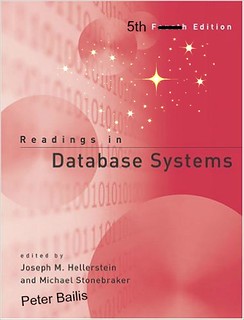Free Red Book: Readings in Database Systems, 5th Edition
 Wednesday, December 9, 2015 at 8:56AM
Wednesday, December 9, 2015 at 8:56AM 
For the first time in ten years there has been an update to the classic Red Book, Readings in Database Systems, which offers "readers an opinionated take on both classic and cutting-edge research in the field of data management."
Editors Peter Bailis, Joseph M. Hellerstein, and Michael Stonebraker curated the papers and wrote pithy introductions. Unfortunately, links to the papers are not included, but a kindly wizard, Nindalf, gathered all the referenced papers together and put them in one place.
What's in it?
- Preface
- Background introduced by Michael Stonebraker
- Traditional RDBMS Systems introduced by Michael Stonebraker
- Techniques Everyone Should Know introduced by Peter Bailis
- New DBMS Architectures introduced by Michael Stonebraker
- Large-Scale Dataflow Engines introduced by Peter Bailis
- Weak Isolation and Distribution introduced by Peter Bailis
- Query Optimization introduced by Joe Hellerstein
- Interactive Analytics introduced by Joe Hellerstein
- Languages introduced by Joe Hellerstein
- Web Data introduced by Peter Bailis
- A Biased Take on a Moving Target: Complex Analytics by Michael Stonebraker
- A Biased Take on a Moving Target: Data Integration by Michael Stonebraker
Related Articles




















